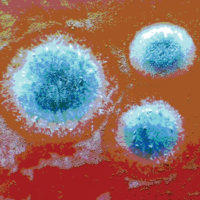The principal source of microbial contamination associated with most processed food products manufactured in the U.S. is the post-processing environment. Many people do not expect dry products to present microbiological contamination, much less foodborne illness. However, this paradigm is changing. During April and May 1998, dry cereal was implicated in an outbreak of salmonellosis. A total of 209 cases were reported across 11 states with at least 47 people hospitalized. This resulted in a voluntary recall of approximately three million pounds of cereal. Dry cereal was not believed to present a risk from foodborne pathogens prior to this event.
Other dry products have also been implicated in foodborne illness, particularly salmonellosis. Intermediate moisture foods (e.g., those with water activity between 0.60 and 0.85) are also included in this discussion. Chocolate, paprika, potato chips and dried milk are additional dry products that have also been associated with foodborne salmonellosis. More recently, recalls have occurred that are associated with Enterobacter sakazakii in non-sterile dry infant formula, and this pathogen has been isolated from a number of other dry foods. Neonatal illness from this microbe can be quite severe, including sepsis, meningitis and death.
One may expect dry products to be manufactured or blended in “dry” environments; however, some such as milk powder, dried egg and potato flakes, share both wet and dry manufacturing environments. Additional microorganisms that could grow in dry factory environments in areas where higher humidity or moisture are present and result in food contamination issues include yeasts, molds and Staphylococci. These organisms are able to grow under drier conditions than many other microbes.
Today’s dry foods manufacturing facilities, then, must pay close attention to implementing effective quality assurance (QA) programs that include a focus on microbiological sampling of the factory environment and food product contact surfaces. Here is a fundamental guide to implementing such a program.
The Effective QA Program
The Hazard Analysis and Critical Control Points (HACCP) process control system is an important element in food safety assurance. However, equally important are the prerequisite programs that go into HACCP, including Good Manufacturing Practices (GMPs) as described in the Code of Federal Regulations (21CFR110). A factory with an inadequate HACCP plan that fails to adequately address a microbial hazard may produce a product resulting in foodborne illness. The same can be said for a factory with an excellent HACCP plan but inadequate GMPs reflecting poor microbial control of the factory environment.
The potential for food contamination from the manufacturing environment exists when foods are not biocidally treated in a hermetically sealed end-use container. One typically expects such biocidal conditions in canning or some irradiation applications when approriately done. It would be impractical, if not impossible, to require food processing factory environments to be sterile. Some microorganisms will be present. However, microorganisms that have grown to high populations in the manufacturing environment represent a greater risk than those that have not grown to high populations. The relative risk of product contamination from a non-product contact area in the manufacturing environment where microbes have grown to 1 billion cells is therefore 10 million times greater than in the same area under identical conditions where the microbial population is only 100 cells. Control of microbial growth and migration of microorganisms in the factory environment is critical, as many dry foods are not biocidally treated in their end-use containers.
Principles of Microbial Growth. Microorganisms require moisture, food and time at a suitable temperature for growth. Nutrition for microbial growth is in abundance in food processing facilities, as is time (particularly in areas inaccessible to routine cleaning and sanitation, such as bolted, sandwiched structures that are not routinely taken apart for cleaning). Manufacturing plant environmental temperatures are often in a range suitable for microbial growth. Such growth is also determined by other factors such as oxidation-reduction potential, temperature, presence or absence of inhibitors, and interaction between microbial populations. Microorganisms cannot grow in environments without adequate moisture. Hence, moisture control in the factory environment is the most critical factor influencing microbial growth in the factory environment.
Accumulation of moisture for microbial growth may occur in dry processing environments because of the following, among others:
• Dust accumulations (e.g., on ledges)
• Damp or humid environments (e.g., cooler surfaces may result in condensate formation)
• Sandwiched construction that entraps moist residues
• Leaking water and steam lines
• Personnel tracking wet residues from wet processing areas in dry areas
• Water leakage through roofs or walls (e.g., factories with flat roofs with inadequately sealed penetrations).
• Improper application of water for wet cleaning in dry environments
The probability of prduct contamination from the environment is dependent upon a number of variables, including proximity of microbial growth niches to the product stream, number of niches in the factory, spatial relationships of niches and product stream, microbial population in niches, degree of niche disruption during operations and exposure of the product stream to the environment, among others. Monitoring the environment for microbial growth along with documentation of corrective actions is an important means to control and prevent environmental product contamination. Processors often inquire about which tests should be performed on samples from the factory environment.
Microbial Assays. The process of microbial assay selection should take into account the goals that the factory hopes to achieve by performing the assay(s). Such goals may include the verification of cleaning and sanitation effectiveness, determination of times for cleaning and sanitation frequency, ascertaining the incidence of invasive pathogens in the environment, discovery of environmental sources of microbes, determination of the frequency required for special maintenance procedures, and evaluation of hygiene design and fabrication of food processing equipment and facilities.
There are several specific microbial assays that should be considered, including aerobic plate count (APC), pathogen testing, and yeast and mold testing.
APC. Aerobic plate counts are generally very useful as an indication of general microbial growth in most factory environments, as well as the effectiveness of sanitation. Some areas may exist in the facility where microbial growth and the presence of high microbial populations can be assumed (e.g., drains or both operational or post-operational samples of product contact surfaes used for the manufacture of fermented fods before drying, such as cheese for cheese powder). In these instances, APC data may not be useful. A factory may wish to monitor such areas for microorganisms of particular concern, such as pathogens.
It should be noted that APCs often done with pour plates of typtone glucose yeast extract agar incubated at 35C for 48 hours will not detect certain types of organisms such as strict anaerobes, thermophiles or selected psychrotropic bacteria. If such organisms are of concern, then other assays will be more useful.
Pathogen testing. Production environments with a historical association with a particular pathogen (e.g., Salmonella spp. in the dry milk or chocolate facilities) should be monitored routinely for such organisms. However, such factories should document corrective action in response to positive data. Failure to document corrective actions may create serious economic hardship in the context of regulatory scrutiny (e.g., expanding an existing product recall to a time where the most recent uncorrected environmenal sample postive occurred). Documentation of corrective action esablishes that a factory is seriously attempting to control the microbiology of its environment. Verification of corrective action should include documented environmental sampling data that establishes the effectiveness of such action(s).
Yeast and mold testing. Dry processing environments are more likely to develop problems with contamination from yeasts and molds versus other microbes. This is because yeasts and molds are generally more resistant to dry conditions (e.g., low water activity) than other microorganisms. Thus, factories with dry processing environments should consider monitoring for yeasts and mold counts, particularly if the factory is struggling to control these organisms in their finished product(s).
Environmental Hygiene Monitoring
Members of the bacterial family Enterobacteriaceae include pathogens (e.g., Salmonella, hemorrhagic E. coli, E. sakazakii) and non-pathogens, such as non-pathogenic E. coli and most coliforms. These organisms are easily killed by sanitizers and tests for Enterobacteriaceae, coliforms and E. coli may be useful in assessment of sanitation effectiveness.
A number of approaches to monitoring in the environment exist. Each of these has their own advantages and disadvantages. These include but are not limited to swab, contact plate and sponge techniques for microorganisms and ATP bioluminescence for cleaning. Air quality can be monitored by a variety of techniques, including sedimentation plates, impingers, slit and sieve impactors and centrifugal samplers.
Swab sampling. The use of pre-sterilized, pre-moistened swabs is the most traditional approach to environmental hygiene monitoring. Both qualitative and quantitative assays can be performed. Dilutions can be performed and therefore counts on sites with high microbial populations can be enumerated. They have the advantage of allowing the user to sample small crevices. However, high pressure cannot be applied to the swab nor can swabs be used to sample large surface areas or large product accumulations.
Contact plate sampling. This technique provides for a uniform sample without the use of a template. However, qualitative analyses are not able to be performed with this approach. Nevertheless, quantitative recovery of low numbers of bacteria can be achieved. Dilutions cannot be performed with this assay; hence high numbers of microbes cannot be accurately determined. Neither irregular nor large surfaces or large product accumulations can be effectively sampled by this method.
Sponge sampling. This method has the advantage of being able to cover large surfaces and can be used for quantitative and qualitative determinations. Dilutions can be performed enabling the analyst to determine high microbial populations more accurately than if dilutions could not be performed. More pressure can be applied with a sponge compared to a swab during sampling of a surface. This will enable the sample taker to better dislodge entrapped biofilms. Large accumulations of residue can also be sampled better than in the previous examples. However, sponges cannot be used to effectively sample small crevices or penetrations. A combination of approaches may therefore be necessary when sampling the factory environment. Sponge sampling was reported to recover Salmonella more frequently than swab sampling in one study.
ATP bioluminescence. All living organisms contain adensoine triphosphate (ATP). Bioluminescent systems measure the presence of ATP in a sample using an enzyme system from fireflies, luciferin-luciferinase. This enzyme system, plus a little oxygen and magnesium, will emit light if ATP is present. The amount of light may be related to the concentration of ATP in the sample.
Bioluminescent methods in the form of luminometers and ATP swabs/sponges have found several niches in the food processing industry. Its most prominent use is as a tool to monitor the efficacy of cleaning on equipment and product contact surfaces in the plant. The hand-held luminometer method has the advantage of providing a very rapid result—often in seconds—of the general cleanliness of equipment and food contact surfaces. The application also allows efficacy of sanitation to be used as a critical control point (CCP) in HACCP because results can be obtained quickly and easily. If a positive reading is revealed, the opportunity to re-clean the suspect area should be taken before start up of the processing line.
Selection of Sampling Sites
The selection of sampling sites should be done based upon the aforementioned goals described. Dry foods manufacturers should perform pre-operational, operational and post-operational sampling.
Pre-operational samples. The goal of pre-operational sampling is to provide verification of the effectiveness of cleaning and sanitation on food contact surfaces prior to their use in production. This data may be useful to establish a sanitation “break point” in the event of product contamination, which has also been used to provide some justification for limiting the manufacturing dates of lots recalled or further tested. In general, sanitation is validated via APCs and coliform counts on food contact surfaces. Truncated assays that incorporate the intitial phases of a pathogen assay on pre-operational samples but stop before it eliminates the potential sample microflora to a specific genus level have been used to validate that product contact surfaces are free of a particular pathogen. These types of assays, when carefully designed, highlight the need for improvements in sanitation when positive and are typically without regulatory significance when recovery of a broader group of other non-pathogenic bacteria is also likely. Experience indicates many companies elect to test such surfaces in this manner to validate the absence of a pathogen on the surface assayed (e.g., “Listeria-like” or “esculin hydrolyzing bacteria”) or bacterial family, Enterobacteriaceae (which may include Salmonella spp., as well as coliforms and other typically non-pathogenic bacteria).
Members of the bacterial family Enterobacteriaceae and other non-spore-forming microbes, such as coagulase positive Staphylococci or yeasts, are easily destroyed by effective sanitation.
Operational and post-operational samples. The goal of operational and post-operational sampling should be to find microbial growth niches and to monitor progress in controlling microbial growth and movement throughout the factory environment. Sampling a piece of equipment on or near a product contact surface periodically throughout the day over many days can be used to establish appropriate interventions when microbial growth is detected. For example, the manufacturer might find that the sampling results indicate that cleaning and sanitation frequency should be established or increased, or that soiled equipment should be switched at some frequency with previously cleaned and sanitized equipment in the processing environment.
Outside customer requirements. Recipient companies are more frequently attempting to compel their suppliers to divulge all results from internal environmental testing plans. This often puts undue pressure on product suppliers to provide a superficial sampling program. In this author’s opinion, companies that want this information are better off either performing their own or authorizing third-party environmental sampling audits of their suppliers.
Routine vs. Investigational Sampling
Routine sampling of preselected sites in the plant (usually on a rotational basis) is advisable. Such programs should also provide some flexibility to sample suspected areas that may develop. Investigational sampling is advisable if an uncontrollable problem area is found in the environment, if pre-operational samples indicate sanitation failures, or in the unfortunate event of a finished product pathogen contamination.
Investigational sampling is not routine sampling. The focus is on areas with a high probability of microbial growth, especially in areas that may result in product contamination. Frequently, equipment is broken down in a more rigorous fashion than with routine sampling. This may be especially true in the event of product contamination with an invasive pathogen, such as Salmonella. Companies typically seek to rigorously find and eliminate all sources of the pathogens that may contaiminate both the product stream and the factory environment, in these situations. Such companies are well advised to shut down selected operations for the purposes of investigational observation and sampling of the factory environment and equipment before sanitation. They should then take, validate and document corrective actions in light of these observations and test data. Prior to shutdown and post-operational sampling some non-contact environmental samples can be carefully taken during operations, as well. This is a good time to observe potential routes of contamination. When the company is confident that the problem may have been solved, all products on previously contaminated lines should be subjected to a rigorous, statistically appropriate hold-and-test program after documented corrective actions are taken and until greater confidence in the finished product safety is gained.
In this context, validation of effective sanitation before start-up of previously contaminated lines may involve pathogen testing. Pathogen recovery from food product contact surfaces implicates product produced on production lines between validated sanitation events is contaminated, regardless of finished product test data. It is prudent to remember that finding a site of finished product contamination does not mean that all possible contamination sites have been recovered. Hence, the need for rigor in the investigation and subsequent validation that problem areas have been corrected.
A Word of Warning
Improvements in food surveillence in the U.S. through Food Net/Pulse Net, continued improvements in microbial method sensitivity and accuracy, increased awareness of the risks that dry products can present to human health by regulatory agencies with attendant increases in sampling by these same agencies, means that the number of food-related recalls in the U.S. associated with dry products will likely increase. This can occur despite continued food safety improvements in the industries involved and will force dry products producers to ever-higher standards of safety and quality. A dry food manufacturer can ill afford not to understand and control the microbial ecology of the factory environment(s) in light of these developments. o
Jeffrey L. Kornacki, Ph.D., is President and Senior Technical Director of Kornacki Food Safety Associates LLC in Madison, WI, where he provides assistance to the food industry related to microbiological troubleshooting, food safety training, research design, and laboratory quality systems. During his more than 25 years in professional food safety microbiology, Dr. Kornacki spent 12 years performing microbiological troubleshooting in over 400 factories as a laboratory director with Silliker Laboratories Group, Inc. He has assisted a number of companies in the midst of FDA and USDA product recalls over the years and spent three years as an Assistant Professor at the Center for Food Safety and Department of Food Science, University of Georgia, Griffin campus, where he is now an adjunct assistant professor. Kornacki is also adjunct faculty with Michigan State University’s National Food Safety & Toxicology Center.
Microbiological Sampling in the Dry Foods Processing Environment




